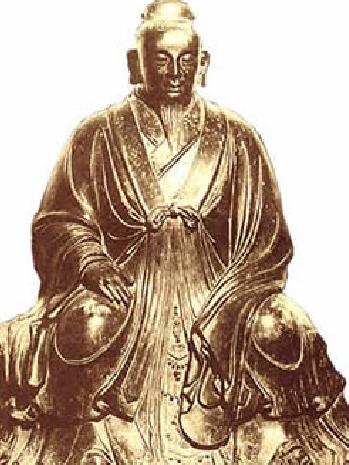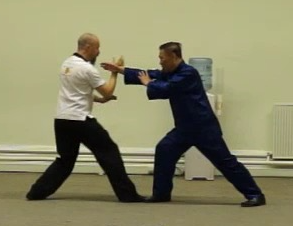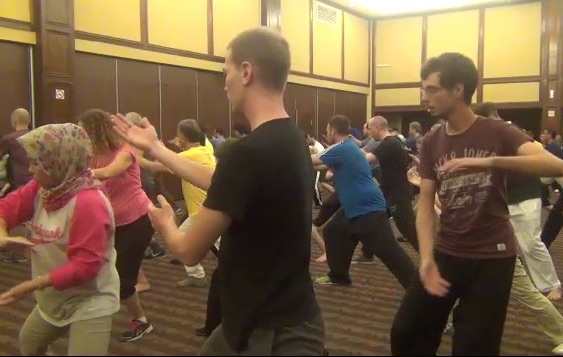TEN ESSENTIALS OF TAIJIQUAN

The Immortal Zhang San Feng
Zhang San Feng gave ten essential points on the practice of Taijiquan. Following these ten essentials is known literally as "No Two Door" which means the "Gate of No Other Way". Zhang San Feng emphasized that there were no other ways to practice Taijiquan.
The Ten Essentials in Taijiquan Practice
- Empty your mind of all thoughts
- Do not tense any muscles
- Loosen your waist
- Principle of false-real
- Principle of sinking and pressing
- Using intention and not using strength
- Co-ordination of top and bottom
- Integration of internal and external
- One gentle, graceful flow without any break
- Movement in stillness, stillness in movement
As soon as a student thinks of anything, i.e. intellectualizes, he is out of a chi kung state of mind, which in modern Western term means a heightened state of consciousness. In classical terms, it was described as Entering Tao, Entering Zen, or Entering Silence.
Not tensing any muscles is the key to energy training. Once some muscles are tensed, energy flow is blocked. It is the energy flow that generates internal force. The greater the amount of energy, and the smoother the flow, the greater is the resultant internal force.
Those without any experience or knowledge of internal force would wonder how one can be powerful if he relaxes his muscles. In normal situation, it is muscular tension that gives rise to strength.
Actually the mode of operation is quite similar. When an external martial artist tenses his muscles, he fills his muscles with energy. When an internal martial artist relaxes his muscles and let energy flow through, he also fills his muscles with energy.
But the crucial difference is that the energy of the external martial artist is locked up in his muscles. After some time the locked energy becomes stale and looses its vibrancy, whereas the energy in the muscles of the internal martial artists is continuously flowing, continuously being recharged, thus increasing its vibrancy.
Moreover, flowing energy performs more efficiently than stagnant energy. If your arm muscles are tensed when you move your arm to deflect an opponent's attack, you are moving the muscles in your arm as indivdual stagnate units separated from the rest of your body, whereas if your whole arm is relaxed and energy is flowing through, your arm moves as one flowing unit energetically connected to your whole body.
Taijiquan is well known for the small sized against bigger, stronger opponents. There are two reasons for this remarkable feat. One is internal force, and the other is Taijiquan mechanics. Even if we leave out internal force, by using Taijiquan mechanics alone, one can defeat a bigger, stronger opponent. The key to Taijiquan mechanics is rotation of the waist. It is only when you loosen your waist, that you can rotate it. Loosening the waist also enables you to relax your whole body more readily.
If your movement is meant to really strike an opponent, it is described as "real". If you pretend to strike your opponent with your hand to distract his attention, and kick him below, you hand movement is described as "false", and your kick as "real". There are of course countless other ways to distract your opponent with a "false" movement and strike him with a "real" movement.
If your opponent fails to react correctly to your "false" movement, you change it to a "real" movement. For example, your original intention is to distract your opponent with your hand so that he may not be aware of your kick. But if he fails to respond correctly, your really strike him. On the other hand, you kick is meant to be a "real" movement, but if he responds to it correctly, you change it to a "false" movement. This principle of "false-real" is very useful in Taijiquan, because unlike in external martial arts, it is difficult for opponents to tell which movements are "false" and which are "real".
"Sinking" refers to sinking your stance. "Pressing" refers to pressing into an opponent that he may not escape. These two tactics are emphasized because as Taijiquan is well known for using minimum force against maximum strength, many people may have the wrong impression that a Taijiquan exponent usually retreats and seldom presses forward. Indeed, many inexperienced Taijiquan students do this when sparring with opponents of other martial arts. When their opponents move in to attack, they retreat. This is a big mistake. Eventually they would be pushed against a wall.
What would you do when a big, strong opponent pushes at you and you are not strong enough to push his arms away? An instinctive response is to move back, in which case he keeps pushing at you. The result is that either you fall over backward or there is no more space for you to tetreat.

Sifu Michael Agar sinks to avoid the full force of Grandmaster Wong's attack before deflecting it and pressing back
A typical Taijiquan response is to use the principle of sinking and pressing. Suppose your opponent is at the north and you are at the south in your right Bow-Arrow Stance, and his powerful push is coming straight on from north to south. Sink your stance, moving your body back without moving your feet. This will neutralize the full force of his push. Simultaneously use your right hand to guide the momentum of his push, moving your right hand from north-north-west a short distance towards your own direction, then divert his momentum in a smooth curve and press forward toward north-north-east, returning to your original right Bow-Arrow Stance. This is actually what we do in our basic Taijiquan Pushing Hands.
You will find that you need only minimum force to divert his maximum strength. It is like driving a truck. You just turn the steering wheel. Here, the rotation of your waist, not the movement of your hand, is the steering wheel. This principle of sinking and pressing can be used against any form of powerful attack, regardless of whether it is a strike, a kick, a felling attack or a chin-na technique.
Using intention and not using strength is a fundamental principle in Taijiquan. Although many people mention this principle, they do not really know what it means, much less how to apply it. One can operate this principle well only when he has the skills of energy flow, otherwise even when he operates it correctly he has no speed nor force, which are essential for effective combat.
This principle of using intention and not strength is instrumental in develop internal force in Taijiquan practice. It is also the inspiration that gives rise to our "flow method" in internal force training. You use your mind to direct energy flow which moves your form the way you want according to your intention. You can be very powerful and fast, yet not tired nor panting for breath.
Failure to co-ordinate the top and the bottom may occur at different levels. At the basic level, if your top does not co-ordinate with your bottom, like if your body is not in alignment with your standing leg in the pattern "Golden Tortoise Exposes Back", for example, not only you have poor balance and hence your combat efficiency will be affected, but also you have to tense certain muscles to prevent yourself from falling over, hence creating energy blockage with may be detrimental to health.
At an intermediate level, failure to co-ordinate the top and the bottom may distract rather than focus your energy. For example, in our Bow-Arrow Stance, the two feet are in line and the toes of both feet are hooked inward. In this way the energy flow of both the top and the bottom part of the practitioner is focused at the dan tian, giving him both stability and agility.
However if his feet are slightly wide apart rather than in line, the toes of his front foot point forward, and the toes of his back foot point outward, the energy flow of the top and the bottom part of the practitioner will be diverted to two different directions, thus affecting both his stability and agility.
At a high level the co-ordination of the top and the bottom enables the practitioner to attain six harmonies, i.e. harmonies of spirit, energy, essence, feet, body and hands. In the pattern "Cosmos First Emerges", for example, he starts with his back leg, rotates his body, and completes at his hand, all in one smooth movement, enabling him to have presence of mind, channel his internal force from his dan tian to his hands, move elegantly, and have co-ordination of stance, body and technique.
However, if he fails to co-ordinate the top and the bottom, like completing the movement of his stance first, then moving his hands, thus have two separate movements instead of one smooth flow, even if his established form is perfect, there is a break in his momentum which will affect his spirit and energy.
There are different ways to differentiate between internal and external training, as well as to differentiate between an internal and an external martial art. A time-honoured way is "nei lian jing shen qi, wei lian jin gu pi", which means "internal training involves essence, spirit and energy; external training involves muscles, bones and skin".
An internal art is one that focuses on internal training, and external art is one that focuses on external methods. Three-Circle Stance, meditation and Abdominal Breathing, for example, are internal methods. Weight training, striking poles and stretching exercise are external methods.
Although Taijiquan is an internal martial art, the internal and external are integrated in its training. In other words, not only a Taijiquan practitioner should not neglect its external aspects, they are essential parts of his internal training, meaning that without the external aspects there can be no internal training.
For example, when he uses the Three-Circle Stance to develop mental clarity and internal force, he needs the form of the stance to train. If his form is incorrect, not only he does not derive benefit from the training, he may have adverse effects. When he employs any Taijiquan technique in combat, he must ensure that the movement and positioning of his feet, body and hands are perfect. If they are faulty, not only he would be unable to deploy his internal force efficiently, the technique itself may not be effective.
Taijiquan techniques are performed in one gentle, graceful flow without any break in between. Once started, there is no beginning and no ending until the objective is accomplished. In performing the first sequence of Wudang Taijiquan, for example, you do not pause after "Nebula Evolving Round", then start to perform "Cosmos First Emerges", pause again, then perform "Riding Horse Ask Way". You perform all these patterns smoothly without any break as if they are one long continuous pattern.
When you apply these patterns in combat, you also perform them smoothly as if they are just one continuous pattern. If an opponent attacks you with a thrust punch, for example, you may ward of the attack with "Nebula Evolving Round". You do not stop or even pause after this, but move continuously to "Cosmos First Emerges" to strike him or fell him onto the ground.
If he retreats, you move forward without any break in between to strike him or fell him with "Riding Horse Ask Way". If, instead of retreating, he deflects your "Cosmos First Emerges" and counter-strikes at you, you can also move continuously to "Riding Horse Ask Way" to deflect his attack, and without any break continue with whatever appropriate techniques until you accomplish the objective of defeating him.
"Movement in stillness, stillness in movement" is another one of Taijiquan principles that is often quoted but little understood. It is actually quite simple. When you perform any Taijiquan movements in solo practice or combat, your mind is still, meaning you are mentally relaxed and clear. When you keep still in meditation, stance training or in a poise pattern during combat, your mind and physical form are still, but your energy is flowing.
These "ten essentials" are ten gems given by Zhang San Feng to Taijiquan practitioners to attain good health (including vitality and longevity), combat efficiency and spiritual fulfillment.
Wong Kiew Kit
30th August 2011
Taragona, Spain

Taijiquan is to be performed in one sooth flowing movement as demonstrated here students at a Taijiquan review course in 2005
LINKS
